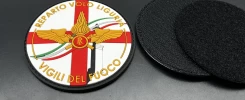Are there any special tools needed for sewing PVC patches?
Sewing PVC patches onto various items can add a unique, personalized touch to clothing, bags, or accessories. While the process might seem straightforward, due to the nature of PVC material, there are some special considerations regarding the tools you’ll need.
Needles
Type of Needles
When sewing PVC patches, a sharp, fine – pointed needle is essential. Regular needles used for fabric may not be sufficient as PVC has a different texture and density. A leather or denim needle is often a good choice. These needles have a sharp, triangular point that can easily penetrate the PVC without causing it to fray or tear. The triangular shape helps to cut through the material cleanly, leaving a small, precise hole for the thread to pass through.
The size of the needle also matters. For thinner PVC patches, a smaller – sized needle, such as a size 11 or 12, can be used. This ensures that the holes made in the PVC are not too large, which could potentially weaken the patch or cause it to leak (if the PVC is used in an application where fluid – tightness is important). For thicker PVC patches, a slightly larger needle, like a size 14 or 16, may be required to push through the material effectively.
Thread
Suitable Thread Options
The thread you choose for sewing PVC patches should be strong and durable. Polyester thread is a popular choice as it offers good strength and resistance to abrasion. It can withstand the stress of sewing through PVC without breaking easily. Nylon thread is another option, known for its high tensile strength and flexibility.
When selecting the color of the thread, it’s important to consider the appearance of the patch. If you want the stitches to blend in, choose a thread color that matches the PVC patch. However, if you’re going for a more decorative look, a contrasting thread color can add an interesting visual element.
Scissors
Appropriate Scissors
To cut PVC patches to the desired shape, you need sharp scissors. Regular fabric scissors may become dull quickly when cutting PVC. Instead, use scissors specifically designed for cutting plastic or heavy – duty materials. These scissors have a sharper edge and a stronger blade construction to handle the toughness of PVC.
For more intricate cuts or when working with small – sized patches, a pair of embroidery scissors can be useful. They have a fine, pointed tip that allows for precise cutting, which is ideal for creating detailed shapes or trimming excess PVC around the edges of the patch.
Other Tools
Pins
While pins are commonly used in fabric sewing, using them with PVC can be a bit tricky. PVC is less porous than fabric, and pins may not hold as securely. However, you can still use them to temporarily hold the patch in place during the sewing process. It’s advisable to use fine – tipped pins to minimize the damage to the PVC surface. You may also want to use fewer pins than you would with fabric, as removing them can sometimes leave small holes in the PVC.
Thimble
A thimble can be a helpful tool when sewing PVC patches. Since PVC is often thicker and more resistant to penetration than fabric, pushing the needle through can require more force. A thimble protects your finger from getting pricked and provides better control over the needle, especially when sewing through multiple layers of PVC or when the patch is attached to a thick fabric base.
Glue (Optional)
In some cases, using a small amount of fabric – friendly glue can assist in the sewing process. Before sewing, you can apply a thin layer of glue around the edges of the PVC patch to hold it in place on the fabric. This can be particularly useful when working with curved or irregular – shaped patches, as it helps keep the patch from shifting during sewing. Just make sure to use a glue that is compatible with PVC and will not damage the material or cause discoloration.
In conclusion, while sewing PVC patches doesn’t require an entirely new set of tools, using the right ones can make the process smoother and ensure a better – quality result. By investing in the appropriate needles, thread, scissors, and other supplementary tools, you’ll be well – equipped to create beautiful, long – lasting PVC patch designs on your favorite items.


